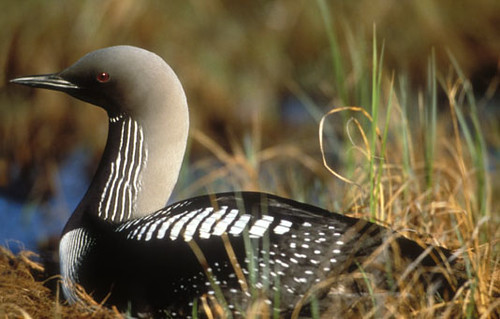
Nesting Pacific loon, Gavia pacifica.
Photograph by PicsMan.
Birds in Science
Two carefully planned sets of experiments to be published on Friday in the top-tier peer-reviewed journal, Science, show intelligent birds and great apes can plan into the future in a way that transcends simple food caching, as squirrels, foxes and other animals do. "Together with recent evidence from scrub jays, our results suggest that future planning is not a uniquely human ability, thus contradicting the notion that it emerged in hominids only within the past 2.5 to 1.6 million years," wrote Nicholas Mulcahy and Josep Call of the Max Planck Institute for Evolutionary Anthropology in Leipzig.
 Seventeen years after the Exxon Valdez (pictured), ran aground in Alaska's Prince William Sound [map of the affected area, oil spill trajectory, and chronology of the event], compelling new evidence suggests that remnants of the worst oil spill in U.S. history extend farther into tidal waters than previously thought, increasing the probability that the oil is causing unanticipated long-term harm to birds and wildlife. The study, by research chemist Jeffrey Short and colleagues at the National Marine Fisheries Service in Juneau, Alaska, is scheduled to appear in the June 15 print issue of the American Chemical Society's journal, Environmental Science & Technology. [Photographer: Macon Cowles.]
Seventeen years after the Exxon Valdez (pictured), ran aground in Alaska's Prince William Sound [map of the affected area, oil spill trajectory, and chronology of the event], compelling new evidence suggests that remnants of the worst oil spill in U.S. history extend farther into tidal waters than previously thought, increasing the probability that the oil is causing unanticipated long-term harm to birds and wildlife. The study, by research chemist Jeffrey Short and colleagues at the National Marine Fisheries Service in Juneau, Alaska, is scheduled to appear in the June 15 print issue of the American Chemical Society's journal, Environmental Science & Technology. [Photographer: Macon Cowles.]
 Scientists found fossilized depressions and footprints (pictured) in Alaska's Denali National Park and Preserve, in what is believed to be the first evidence of prehistoric wading birds probing ancient mud for food, said Phil Brease, a geologist at Denali National Park. The tracks and the feeding marks found in rocks formed from freshwater sediments were 65 million to 70 million years old, said Brease. Such evidence of prehistoric birds' feeding behavior is difficult to find, because the marks made in the mud disappear easily, and the fossilized evidence often erodes. [Photo: National Park Service]
Scientists found fossilized depressions and footprints (pictured) in Alaska's Denali National Park and Preserve, in what is believed to be the first evidence of prehistoric wading birds probing ancient mud for food, said Phil Brease, a geologist at Denali National Park. The tracks and the feeding marks found in rocks formed from freshwater sediments were 65 million to 70 million years old, said Brease. Such evidence of prehistoric birds' feeding behavior is difficult to find, because the marks made in the mud disappear easily, and the fossilized evidence often erodes. [Photo: National Park Service]
People Hurting Birds
BirdLife International's annual evaluation of how the world's bird species are faring shows that the total number considered threatened with extinction is now 1,210. When combined with the number of near threatened species this gives a total of 2,005 species in trouble - more than one in five of the planet's 9,799 total species. "We face a huge challenge in improving the status of the 1,210 threatened and 795 near threatened species. But the success stories show that concerted conservation action can save these birds from extinction: we just need the political will and resources," said Dr Stuart Butchart, BirdLife's Global Species Program coordinator.
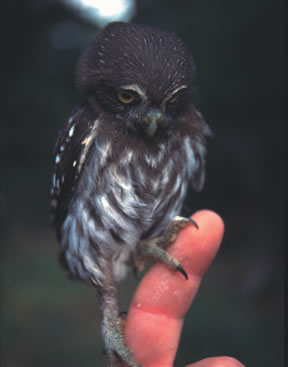 I've written and link to stories about the cactus ferruginous pygmy-owl, Glaucidium brasilianum cactorum (pictured), a tiny bird that has been at the center of a battle between environmentalists and developers for years. All that comes to a head today when this bird will be officially removed from the endangered species list. Conservation groups have filed suit in Tucson, Arizona, challenging the decision to remove the owl from the list and requesting a temporary restraining order to block it.
I've written and link to stories about the cactus ferruginous pygmy-owl, Glaucidium brasilianum cactorum (pictured), a tiny bird that has been at the center of a battle between environmentalists and developers for years. All that comes to a head today when this bird will be officially removed from the endangered species list. Conservation groups have filed suit in Tucson, Arizona, challenging the decision to remove the owl from the list and requesting a temporary restraining order to block it.
Alarmed by an explosion of cormorants, state biologists have declared war on the birds in seven states, including Ohio and Pennsylvania. Before 1972, cormorants were disappearing. Anyone was allowed to shoot them and the pesticide DDT made their eggshells so thin that adults often crushed their young. But the federal government began protecting the birds in 1972 and outlawed DDT soon after, helping them to recover their former populations. Expanding fish hatcheries and growing populations of small fish in the Great Lakes also helped, providing better sources of food, said Shauna Hanisch, a Fish & Wildlife Service biologist.
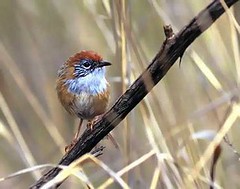 A tiny bird could force the State Government to scrap plans for a toxic waste dump in Victoria's Riverland in Australia. Federal Environment Minister Ian Campbell would not rule out intervening in the project at Nowingi, 50km south of Mildura, after the Mallee emu-wren, Stipiturus mallee (pictured), was added to a "red list" of endangered species this month. The World Conservation Union's vulnerable assessment says the wren faces a "high risk" of extinction, with one of its last strongholds in the proposed dump area. [Photographer: Rob Drummond]
A tiny bird could force the State Government to scrap plans for a toxic waste dump in Victoria's Riverland in Australia. Federal Environment Minister Ian Campbell would not rule out intervening in the project at Nowingi, 50km south of Mildura, after the Mallee emu-wren, Stipiturus mallee (pictured), was added to a "red list" of endangered species this month. The World Conservation Union's vulnerable assessment says the wren faces a "high risk" of extinction, with one of its last strongholds in the proposed dump area. [Photographer: Rob Drummond]
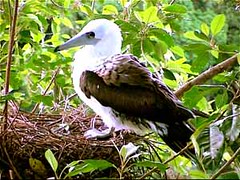 The Australian Government has sidestepped its own environmental laws to build a $336 million detention center on Christmas Island [map], despite the facility being nestled between pristine rainforest and national parkland that is home to an endangered Australian bird. The local community has voiced concerns about the project's impact on the Abbott's booby, Sula (Papasula) abbotti (pictured), a bird that breeds only in the island's rainforest. There have also been claims that building work has cut off a red-crab migration route. It is believed some of the crabs, which are also found only on the island 2630km north of Perth, have been killed by heavy machinery. The site of the 800-bed Immigration Reception and Processing Centre lies next to the prime habitat of the Abbott's booby, which is listed as critically endangered by Birds Australia.
The Australian Government has sidestepped its own environmental laws to build a $336 million detention center on Christmas Island [map], despite the facility being nestled between pristine rainforest and national parkland that is home to an endangered Australian bird. The local community has voiced concerns about the project's impact on the Abbott's booby, Sula (Papasula) abbotti (pictured), a bird that breeds only in the island's rainforest. There have also been claims that building work has cut off a red-crab migration route. It is believed some of the crabs, which are also found only on the island 2630km north of Perth, have been killed by heavy machinery. The site of the 800-bed Immigration Reception and Processing Centre lies next to the prime habitat of the Abbott's booby, which is listed as critically endangered by Birds Australia.
Birds Hurting People
Shimshon Badash, 58, from the town of Ramat Hasharon in the heart of Israel is in despair: For over a week now he has been suffering repeated attacks by a crow that lives near his house and is forced to leave his home wearing a helmet and equipped with a parasol in order to protect himself. Ever since that day when Badash rescued a crow chick that fell out of a tree, a crow - probably the chick's mother - began attacking Badash on a daily basis. "When I came back home on Independence Day, the crow began attacking me... several days later I went outside the house and was assaulted again. I felt I was in danger. I tried to run and then fell and injured myself. Whenever I wanted to leave the house, the crow would strike me. I was forced to be on the run constantly," Badash related. GrrlScientist note: If you look carefully, you will notice that the birds pictured with this story are cormorants, probably the pygmy cormorant,Phalacrocorax pygmaeus -- not crows.
People Helping Birds
Rats are a serious threat to the native birds and wildlife of Fiji and other Pacific islands. Three species of rat have been introduced to Fiji: Pacific rats arrived thousands of years ago when the first Fijians arrived, with European black and brown rats more recently. All have devastating impacts on biodiversity and have led to the extinction of innumerable species in the Pacific, along with economic and health problems caused by damage to crops and the spread of diseases. "If all goes to plan, Fiji will remove rats off the two islands in one month [map of the Fiji Islands]. Hopefully these will be the first of many to be de-ratted," said Rob Chappell, specialist consultant who visited both Viwa and Vatuira islands last week.
A conservation "vision" to protect one of the Asia-Pacific region's largest, richest and most pristine wetlands on the island of New Guinea has been officially launched, with governments, community leaders, scientists and conservation organizations declaring their commitment to support it. "The vision highlights and strengthens the need to conserve this globally significant environment and its biodiversity," said Terry Warra, Acting Managing Director of the Papua New Guinea Forest Authority.
Six young bald eagles, Haliaeetus leucocephalus, are settling into their Vermont home atop a penthouse of sorts. At the edge of a small stand of woods, their home has an impressive view overlooking the Dead Creek that flows through the rolling farm fields of the Lake Champlain Valley in Vermont. The birds weigh about eight pounds now, seven weeks after they poked their heads out of their eggs in Maryland as 2-ounce hatchlings. Wildlife professionals and volunteers are feeding and monitoring them in the hope the birds will make Vermont their new homes.
At the recent spring meeting of the Southeastern Association of Fish and Wildlife Agencies (SEAFWA), the wildlife agency directors were advised that Quail Unlimited would partner with them to provide funding for the Northern Bobwhite Conservation Initiative (NBCI) Coordinator position for the next three years. The amount required to fund this position is $75,000 per year for three years and the funding will begin in 2007. The funding was made possible by Quail Unlimited and by Budweiser, which committed future funds from the "Help Budweiser Help The Outdoors" program to NBCI.
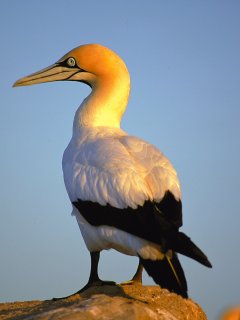 Recently, a handful of Cape gannets, Morus capensis (pictured), dropped in on Bird Island in Lambert's Bay, South Africa, the first to do so since the birds were driven away by seals that had begun preying on the breeding colony last summer. Ornithologists are holding thumbs that this is a sign that the many thousands of gannets will return to breed on the island where generations of the birds have done since 1912, but they say it is too early to tell. Anton Wolfaardt, regional ecologist for CapeNature, said two gannets had returned one day last week and nine the next day. [Photographer: BirdLife South Africa]
Recently, a handful of Cape gannets, Morus capensis (pictured), dropped in on Bird Island in Lambert's Bay, South Africa, the first to do so since the birds were driven away by seals that had begun preying on the breeding colony last summer. Ornithologists are holding thumbs that this is a sign that the many thousands of gannets will return to breed on the island where generations of the birds have done since 1912, but they say it is too early to tell. Anton Wolfaardt, regional ecologist for CapeNature, said two gannets had returned one day last week and nine the next day. [Photographer: BirdLife South Africa]
Birds Helping People
"The decline in the agricultural workforce has been just as dramatic as the decline of skylarks," observed Soil Association policy director, Peter Melchett, in a recent news conference, referring to the British bird whose population has fallen sharply. Melchett said British policymakers tended to focus on the benefits of organic farming for biodiversity but should pay more attention to social benefits such as job creation. Organic farming can help reverse a sharp decline in Britain's agricultural workforce, creating on average 32 percent more jobs than conventional farming, according to a study issued by the Soil Association on Monday.
Ivory-billed Woodpecker News
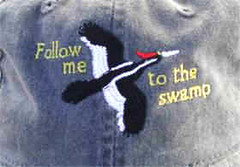 After three seasons of searching no one has yet to take even a single photograph of a clearly identifiable ivory-billed woodpecker, Campephilus principalis. "We probably wouldn't be truthful if we said we weren't a little disappointed. We've put a lot of effort into this," said Cornell University researcher, Ron Rohrbaugh. Cornell, this nation's foremost ornithological research institution, said that it still believes the ivory-bill was spotted two years ago, but no longer plans to go on spending $1 million a year, mostly from private donations but including some federal funds, to find it. Critics say the inability to get a photograph of the bird supports their doubts about Cornell's original announcement. Next year's search, if there is to be one, will rely mainly on volunteers, with Cornell sending in an "ivory-bill SWAT team" if anything interesting turns up.
After three seasons of searching no one has yet to take even a single photograph of a clearly identifiable ivory-billed woodpecker, Campephilus principalis. "We probably wouldn't be truthful if we said we weren't a little disappointed. We've put a lot of effort into this," said Cornell University researcher, Ron Rohrbaugh. Cornell, this nation's foremost ornithological research institution, said that it still believes the ivory-bill was spotted two years ago, but no longer plans to go on spending $1 million a year, mostly from private donations but including some federal funds, to find it. Critics say the inability to get a photograph of the bird supports their doubts about Cornell's original announcement. Next year's search, if there is to be one, will rely mainly on volunteers, with Cornell sending in an "ivory-bill SWAT team" if anything interesting turns up.
Avian Influenza
Over the past year, the spread of the flu has never been correlated with the migratory routes and seasons of wild birds. Indeed, some global studies have found that migratory birds are not the cause of the current wave of bird flu outbreaks found in large parts of the world. Rather, outbreaks have been concentrated in the factory farms of China, South East Asia and elsewhere in the world. In India, the epicenter of outbreak of bird flu took place in 18 poultry farms in and around Navapur in Maharashtra. Since the Qinghai Lake, China, outbreak last year, outbreaks in other parts of world have occurred along major transport routes for domestic birds: increasing evidence suggests that commercial poultry and its products, not migratory bird populations, are the likely vectors of avian flu. GrrlScientist comment: It's about time these people came to their senses: I've been saying this for years now.
"One migratory bird does not a pandemic make," said Dr. Anthony Fauci, director of the National Institute of Allergy and Infectious Diseases. "It is entirely conceivable that this virus is inherently programmed that it will never be able to go efficiently from human to human," Fauci explained. "Hopefully the epidemic (in birds) will burn itself out, which epidemics do, before the virus evolves the capability of being more efficient in going from human to human." [interactive map of the world's migratory flyways for wild birds].
This interesting article is a personal story of the 1918 Influenza pandemic outbreak that claimed millions of people's lives worldwide.
Streaming Birds
 This week on BirdNote, you will hear about; Monday, City Peregrines; Tuesday, ducks on the wane; Wednesday, revisiting the Great Horned Owl nest; Thursday, singing sandpipers; and Friday, Cartoon birds; Henry Hawk meets Foghorn Leghorn. BirdNotes transport the listener out of the daily grind with two-minute vignettes that incorporate the rich sounds of birds provided by Cornell University and by other sound recordists, with photographs and written stories that illustrate the interesting -- and in some cases, truly amazing -- abilities of birds. Some of the shows are Pacific Northwest-oriented, but many are of general interest. BirdNote can be heard live, Monday through Friday, 8:58-9:00AM in Western Washington state and Southern British Columbia, Canada, on KPLU radio and now also in North Central Washington state on KOHO radio. All episodes are available in the BirdNote archives, both in written transcript and mp3 formats, along with photographs. Listener ideas and comments are welcomed. [rss mp3/podcast].
This week on BirdNote, you will hear about; Monday, City Peregrines; Tuesday, ducks on the wane; Wednesday, revisiting the Great Horned Owl nest; Thursday, singing sandpipers; and Friday, Cartoon birds; Henry Hawk meets Foghorn Leghorn. BirdNotes transport the listener out of the daily grind with two-minute vignettes that incorporate the rich sounds of birds provided by Cornell University and by other sound recordists, with photographs and written stories that illustrate the interesting -- and in some cases, truly amazing -- abilities of birds. Some of the shows are Pacific Northwest-oriented, but many are of general interest. BirdNote can be heard live, Monday through Friday, 8:58-9:00AM in Western Washington state and Southern British Columbia, Canada, on KPLU radio and now also in North Central Washington state on KOHO radio. All episodes are available in the BirdNote archives, both in written transcript and mp3 formats, along with photographs. Listener ideas and comments are welcomed. [rss mp3/podcast].
BirdCams
There is another bald eagle webcam in Battle Point, Washington, that is hosted by the Washington State Department of Fish and Wildlife.
Linked here is a large collection of video depicting a nesting pair of rare white-tailed sea-eagles, Haliaeetus albicilla. Incidentally, a pair of these birds has been seen nesting in Holland's national park, Oostvaardersplassen. An unknown number of chicks hatched about a month ago. The nest is built in an inaccesable part of the park, and it cannot be visited.
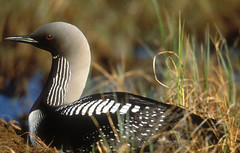 Not enough webcams linked so far? Well, take a look at this website that features a perhaps one hundred bird nest cams from around the world. Let me know if you find one that you especially like! My favorite link there is the live, streaming Pacific loon cam, Gavia pacifica (pictured, also at top) [RealPlayer], which I have been watching almost all day (Sunday) while I wrote this issue of Birds in the News. This nest is located on an artificial platform on Connors Lake, west Anchorage, Alaska, near an airport. I can hear airplanes (very loud) and sometimes see their reflection in the water as they take off, yet mom doesn't budge at all! I can also hear several species of ducks, crows and ravens, and also Lapland longspurs singing in the background. When momma loon got off the nest briefly (approximately 2 minutes), I counted two large, greenish-grey eggs.
Not enough webcams linked so far? Well, take a look at this website that features a perhaps one hundred bird nest cams from around the world. Let me know if you find one that you especially like! My favorite link there is the live, streaming Pacific loon cam, Gavia pacifica (pictured, also at top) [RealPlayer], which I have been watching almost all day (Sunday) while I wrote this issue of Birds in the News. This nest is located on an artificial platform on Connors Lake, west Anchorage, Alaska, near an airport. I can hear airplanes (very loud) and sometimes see their reflection in the water as they take off, yet mom doesn't budge at all! I can also hear several species of ducks, crows and ravens, and also Lapland longspurs singing in the background. When momma loon got off the nest briefly (approximately 2 minutes), I counted two large, greenish-grey eggs.
Bird Gift Ideas
 If you, dear readers, are looking to buy a T-shirt, you should check out Jimmy Buffet's Margaritaville website. Buffett is donating $1 to the National Fish and Wildlife Foundation for the Puerto Rican Parrot Recovery Program for every t-shirt sold, and you will end up with a fine looking t-shirt, too!
If you, dear readers, are looking to buy a T-shirt, you should check out Jimmy Buffet's Margaritaville website. Buffett is donating $1 to the National Fish and Wildlife Foundation for the Puerto Rican Parrot Recovery Program for every t-shirt sold, and you will end up with a fine looking t-shirt, too!
Miscellaneous Birds
"They're all up there in the air, migrating while we sleep, on high highways of wind," said Jeff Wells, the senior scientist at the Boreal Songbird Initiative, a conservation group that tries to protect the endangered boreal, or northern, forest that stretches from Alaska to Newfoundland and is the summer home of three to five billion birds. Birds migrate at night to avoid predators, Wells said, and because the atmosphere tends to be calmer. They also may be able to use celestial cues better in the dark. There are various ways to view birds at night, or you can simply listen. Birds call all the time while flying, Wells said, and in the spring some break into song overhead. A high-powered microphone can be set up at home, even in the city. "If you know to put your ears up and listen, you'll hear birds, and life is changed forever," Wells said. "You can't step out without saying, 'My God, there's a current of birds going overhead.' "
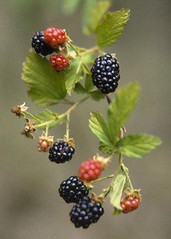 The naturalists at Hilton Pond Center have always been intrigued by the phrase "Blackberry Winter", but last week, they actually got to experience it first-hand at Hilton Pond Center for Piedmont Natural History. For an explanation of "Blackberry Winter"" and some photos of organisms associated with it, please visit last week's installment of This Week at Hilton Pond. As always, they include a list of birds that were banded and recaptured locally during the period; this week there's also a report on a migratory American goldfinch, Carduelis tristis, that was banded locally and encountered far to the north. [Photographer: Bill Hilton, Jr.]
The naturalists at Hilton Pond Center have always been intrigued by the phrase "Blackberry Winter", but last week, they actually got to experience it first-hand at Hilton Pond Center for Piedmont Natural History. For an explanation of "Blackberry Winter"" and some photos of organisms associated with it, please visit last week's installment of This Week at Hilton Pond. As always, they include a list of birds that were banded and recaptured locally during the period; this week there's also a report on a migratory American goldfinch, Carduelis tristis, that was banded locally and encountered far to the north. [Photographer: Bill Hilton, Jr.]
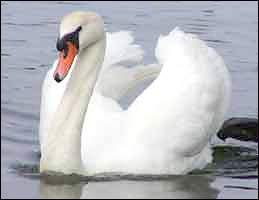 Today, a state biologist is probably hiking somewhere along the shore of Lake Ontario and sneaking into swan nests to coat the large gray eggs with vegetable oil so the developing embryos inside the eggs will suffocate. With nearly 1,500 mute swan pairs in New York, each capable of incubating as many as 10 eggs, it's a massive job. Mute swans, Cygnus olor (pictured), don't belong here, biologists say. They're an invasive species -- native to Europe and Asia -- and state biologists and many birders believe they are driving native ducks and geese from prime nesting grounds.
Today, a state biologist is probably hiking somewhere along the shore of Lake Ontario and sneaking into swan nests to coat the large gray eggs with vegetable oil so the developing embryos inside the eggs will suffocate. With nearly 1,500 mute swan pairs in New York, each capable of incubating as many as 10 eggs, it's a massive job. Mute swans, Cygnus olor (pictured), don't belong here, biologists say. They're an invasive species -- native to Europe and Asia -- and state biologists and many birders believe they are driving native ducks and geese from prime nesting grounds.
Some of you might remember that I recently reviewed Kenn Kaufman's Kingbird Highway, which tells the story of a birder's "Big Year". What you might not know is that birders also form teams that go out to record a Big Day, and they compete against other teams. This is a story about one such competition.
Be sure to check out the "Nickname that Bird" contest" to win a free book - Deadline tonight at midnight!
Previous : : Birds in the News : : Next

The Fine Print: Thanks to my bird pals; Wouter, Mike, Scott, Allison, Ian, Dawn, Jeremy, Ellen and Ron for some of the news story links that you are enjoying here. Thanks in advance to Ian for catching my typos; as you might know by now, I put a few typographical errors in these documents just so Ian can find them! All images that appear here are either linked from the news stories that they accompany or they are linked to the site where they are found, and most of them are resized. You can follow these links by clicking on individual images.
tags: Birds in the News, ornithology, birds, avian, newsletter

Gorgeous loon!
And scrub jays are amazingly smart - though Clark's nutcrackers have a better memory of their caches.
The article on SEED (see on the right, the one about flu-immune pigeons) repeats the dogma that avian flu spread is tied entirely to the migratory bird patterns.
thanks for metioning the "flu immune pigeons". i actually linked to that story in last week's Birds in the News (or was it two weeks ago?).
by the way, did you watch the streaming video of the nesting Pacific loon? it's in the BirdCams category. it's wonderful!
Sorry - I will have to get back to the Birds In The News later - I am teaching tonight and preparing my lecture right now. I'll take a look at everything after that....and I hope we can meet in NYC later this week...
Thanks.
More bird news, especially on the Dutch white-tailed eagles (maybe the first nest ever): here.
BITN just gets better and better since we all persuaded you not to deep-six your excellent ornithological enterprise. The photo of the western loon brings back my memory of being at an inlet on the Texas coast around 65 miles SSW of Houston a couple of years ago. Way out in the bay there swum a solitary common loon, ducking under periodically to take a fish. According to the field guide, this loon species will sometimes live as a solitary. Seeing it out there as a mote on all that water in the gray light of a late afternoon in winter, I thought it a brave and noble bird.
Another gorgeous issue. Laughed myself silly about the Hitchcock's Birds-impersonating crow.